

Reader (298) Work Breakdown Structure Pitfalls: Recognizing and Avoiding Them. Some WBS Pitfalls 1.
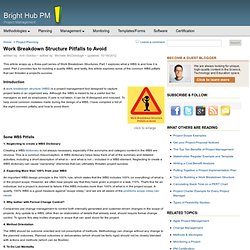
Neglecting to create a WBS Dictionary Creating a WBS dictionary is not always necessary, especially if the acronyms and category content in the WBS are obvious. This ia a common misconception. A WBS dictionary helps keep track of all of the summary and detailed activities, including a short description of what is – and what is not – included in a WBS element. 2. An important WBS design principle is the 100% rule, which states that the WBS includes 100% (or everything) of what is in the project scope. 3. Companies use change management to control both internally generated and customer-driven changes in the scope of projects. 4. Statement of Work: The Blueprint of Your Project. September 29, 2012 | Author: PM Hut | Filed under: Project Plan Development Statement of Work: The Blueprint of Your Project By Paul A.
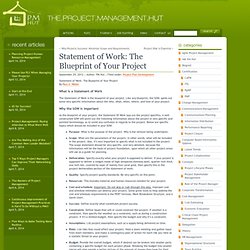
Weber What is a Statement of Work The Statement of Work is the blueprint of your project. Like any blueprint, the SOW, spells out some very specific information about the who, what, when, where, and how of your project. How To Create Project Documentation That Doesn’t Suck. A discussion on management plans started by my friend on Govloop recently about management plans got me going.
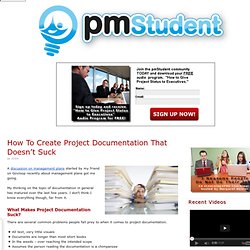
My thinking on the topic of documentation in general has matured over the last few years. I don’t think I know everything though, far from it. How to Document a Project Plan: The 10 Elements of A Good Project Plan. February 23, 2012 | Author: PM Hut | Filed under: Project Management Best Practices, Project Plan Development.
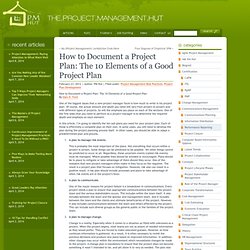
Documentation in the Project Planning Process – Part 4. Posted by Brad Egeland In Part 3 of this series on documentation and communication in the planning process of the project, we covered the design specifications and the project resource plan.
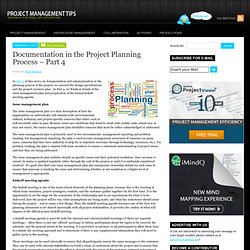
In Part 4, we’ll look at details of the issue management plan and preparation of the formal kickoff meeting agenda. Issue management plan The issue management plan is a clear description of how the organization (or individuals) will contend with environmental, cultural, technical, and project-specific concerns that either exist or will inevitably come to pass.
Because issues are conditions that must be dealt with (unlike risks, which may or may not occur), the issues management plan identifies concerns that must be either acknowledged or addressed. The issue management plan is primarily used in two environments: management reporting and problem tracking. The issue management plan includes details on specific issues and their potential resolution. Kickoff meeting agenda. Documentation in the Project Planning Process – Part 3. Posted by Brad Egeland In Part 2 of this series on documentation and communication in the planning process of the project, we covered the communication plan and the test plan.
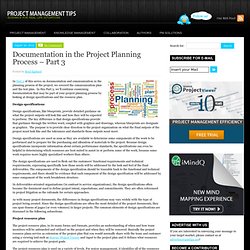
In this Part 3, we’ll continue examining documentation that may be part of your project planning process by looking at design specifications and the resource plan. Design specifications Design specifications, like blueprints, provide detailed guidance on what the project outputs will look like and how they will be expected to perform. The key difference is that design specifications provide that guidance through the written word, coupled with graphics and drawings, whereas blueprints are designate as graphics. Documentation in the Project Planning Process – Part 2. Posted by Brad Egeland In Part 1 of this series on documentation and communication in the planning process of the project, we covered budgets and change control planning.
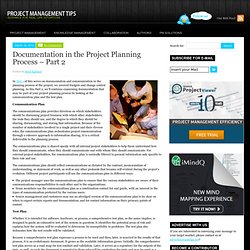
In this Part 2, we’ll continue examining documentation that may be part of your project planning process by looking at the communication plan and the test plan. Communication Plan The communications plan provides direction on which stakeholders should be discussing project business with which other stakeholders, the tools they should use, and the degree to which they should be sharing, documenting, and storing that information. Documentation in the Project Planning Process – Part 1. Posted by Brad Egeland We looked at documentation and communication processes and tools for the project initiation process previously.

Now I’d like to look at some of the critical things we communicate and document during the very important project planning process. Some of these items may have been ‘drafted’ as part of the initiation process or even possibly earlier in the process as someone was working to ‘win’ the project, but this is where they are fine-tuned into usable items on the project. In this Part 1, we’ll discuss budgets and the change control plan. Budgets. A Project Charter for Lazy Teams - PM Hut - Waterfox. February 8, 2012 | Author: PM Hut | Filed under: Project Management Templates A Project Charter for Lazy Teams By James King I have been creating a couple of articles on this context recently - the idea is that if you know a bit about your users and the product that you are building.
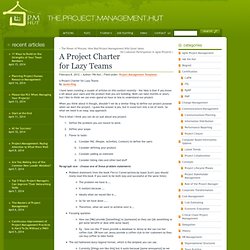
Both can take months or years, but I like to think we can even spend an hour or less to understand our project. When you think about it though, shouldn’t we do a similar thing to define our project purpose when we start the project. I guess the answer is yes, but it could turn into a lot of work. This is what I think you can do on just about any project. Define the problem you are meant to solve. Paragraph one – choose one of these problem statements Paragraph two – say what is in scope and what is not No project ever fully solves a problem from every possible angle. People generally understand that some things will be in scope and that others will be out of scope. Paragraph three onwards. Use Software Requirements Process Flows to Create User Guides. Without user guides, users will not only be slow to adopt a new system or tool—they may be hostile to the change.
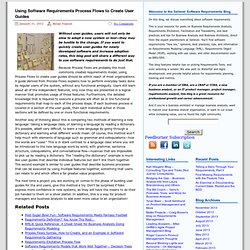
If you want to quickly create user guides for newly developed software and increase adoption rates, this blog post will share a different way to use software requirements to do just that. Because Process Flows are probably the most commonly created requirements model, using Process Flows to create user guides should be within reach of most organizations. A guide derived from Process Flows explains how to perform everyday tasks done by regular users of the system, without any functional ambiguity. Users still learn about all of the independent features, only now they are presented in a logical manner that promotes usage of those features.
Document Decisions Separately and Explicitly – A Proposed Use Case Scenario Best Practice > Business Analyst Community & Resources. This article proposes a use case best practice technique: Always document decisions separately and explicitly in use case scenarios. This practice assists the business analyst in identifying where alternate and exception paths may be needed. Create a Project Plan to Reach Success. In project management, if basic technical knowledge is lacking, or the basics are ignored or underestimated, a project's success is not guaranteed. On the contrary, mastering the project management basics is a prerequisite for project success. PMI's 2012 Pulse of the Profession revealed that organizations that use basic, standardized project management practices have a 71 percent success rate, compared to the average success rate of 64 percent. One of these basic pillar practices is taking the time to create a realistic implementation plan.
But how do we build a comprehensive, yet realistic project implementation plan? Here are a few tips: 1. 2. 4. 5. 6.